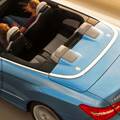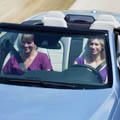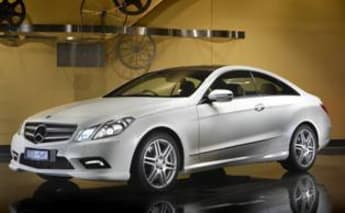 |
|  |
|
The latest Mercedes-Benz E-Class Cabrio comes with two nifty devices both designed to keep you snuggly warm on top-down winter nights.
As if its patented Airscarf was not enough — and capable of blowing warm air over your neck — Benz now also has the Aircap as part of the standard equipment on the fresh-air E when they arrive in Australia in April to replace the superseded CLK droptop.
The system works as a windbreaker to cut drafts into the cabin for both front and rear passengers. It uses a wind deflector that raises six centimetres above the leading edge of the windscreen to deflect the air flow and a net between the rear seats to reduce turbulence in the cabin. The system is so high-tech, using 211 individual components, that Mercedes has taken out 20 patents on the device.

The chief engineer of the E-Class coupe and convertible, Christian Fruh, describes the system as ‘an isle of calm in the middle of a hurricane’. "It quite literally takes wind out of your hair," he says. And the Aircap also cuts noise in the cabin, as well as working with the automatic aircon — which knows when when the roof is up or down to adjust the heating or cooling to compensate.
Apart from the draught stopper, the cabrio also gains a wealth of Mercedes-Benz safety knowhow. The company’s passive safety chief, Kai Visel, says it is as safe as the coupe. "The rollover performance in an accident is the same as the coupe,” he says.
To achieve that, the cabrio uses high-tensile steel, a traditional B-pillar construction, and heavily reinforced body structure that includes more robust A-pillars and twin rollover protection bars that automatically deploy for rear seat passengers. Visel says the car’s torsional rigidity is almost the same as the flagship two-seater SL.
Models and prices
But there is more to the E Cabrio, with four new models for Australia — the first-up petrol V6 and V8 ahead of two four-cylinder models later in the year. First up is the E350 V6 and range topping E500 V8 in April to be followed by the E250 CGI petrol around June and E250 CDI turbodiesel arriving in July.
The V6 cabrio will cost $139,950 while the E500 is $186,950, both a $12,450 increase over the E-Class coupe already on sale. The E250 CGI is tipped to be around $105,000 and the E 250 CDI around $135,000. But Benz says the higher prices for the E350 and E500 including $12,555 and $18,627 more value over the outgoing CLK droptop.
Despite its higher price, the E-Class cabrio is likely to be shopping against the Audi A5 cabriolet and BMW’s 3 Series cabrio. Mercedes did well with the previous cabrio, as 39 per cent of CLK buyers chose the cabrio.
"We expect a similar level of interest for the new cabrio,” says Peter Fadeyev, spokesman for Mercedes-Benz Australia.
Drivetrains
Like the E coupe, the E350 cabrio gets a 170kW/540Nm 3.0-litre V6 and the E500 a 285kW/530Nm 5.5-litre V8. The E500 hits 100km/h in 5.3 seconds and has an electronically limited top speed of 250km/h with economy of 11.0L/100km.
The E250 CGI has a 1.8-litre four cylinder petrol engine that pumps out 150kW/310Nm, delivering 7.8l/100km. The E250 CDI gets a 2.2-litre four-cylinder with 150kW/500Nm with 5.6l/100km. All four-cylinder models get a five-speed automatic while Mercedes' latest’ 7G-tronic seven-speed automatic will be standard on the petrol V6 and V8.
Fadeyev expects the E350 to be the most popular model. However, after the experience with the E-Class sedan in Australia, he believes buyers could be swayed to the new petrol and turbodiesel fours.
"We’ll have to wait and see, but our customers are really warming to the new four-cylinder engines because they deliver plenty of performance without sacrificing fuel economy. The E250CGI could be the dark horse," Fadeyev says.
Benz also claims coupe levels of cabin quietness and integrity. The four-layer acoustic soft-top helps reduce noise. The hydraulic roof is fully automatic, taking 20 seconds to raise or lower at speeds up to 40km/h. It lowers flush with the boot gets its own stowage compartment, with a retractable cover to separate it from the luggage area. With the roof closed the cover can be slid forward to increase capacity by 90 litres to 390 litres. There is also a ski-port for loading long items.
Driving
Firstly, forget strong performance and that solid-as-a-rock Mercedes build quality. The talk is all about the E-Class cabrio's new-found feel good factor, thanks to Aircap and the potential for year-round open top enjoyment. It is so effective that it will allow top down motoring even in the darkest days of winter because it significantly cuts any turbulent air swirling around the cabin.
The device works a treat. It doesn't entirely eliminate the wind-in-the-hair feel but makes cold weather driving a treat. Throw in the heated seats and Airscarf — which will remain an option for Australia — and the cabrio could lure coupe buyers who have never considered a softtop. Because it is changing the cabrio's aerodynamics slightly, the Aircap does eat a little into fuel economy but Mercedes engineers say it is a modest increase.
As with the E-Class sedan and coupe, the cabrio is packed with safety and technology to justify the steep price tag. The four-layer roof is technological work of art. With the roof closed the cabin is as quiet as the coupe.
After driving both the E250 CGI and E500, the V8 is the pick if you have the cash to splash because it works so well with the new seven-speed automatic and has a rorty exhaust note with the top down. But the turbocharged 1.8-litre four is certainly not embarrassed; it's quiet with a strong mid-range for overtaking and the five-speed auto's ratios are perfectly matched to extract the performance from the engine.
The ride and handling in both the four and V8 is perhaps not as sharp as BMW 3-Series cabrio but slicker than the A5 cabrio. It can still double as a boulevard cruiser or swift mountain touring car.
Thanks to the extra chassis stiffening, the cabrio resists scuttle shake and there is very little flexing over even the roughest roads.
The cabrio has a slightly longer wheelbase than the CLK which liberates more cabin room, so both front seat occupants are spoilt for space and legroom. In the back, though, the stronger body meant moving the rear seats inboard so shoulder space is best described as snug. The rear seatback is also quite vertical but this means rear seat passengers sit slightly higher and have a better view out front.
Visually the cabrio styling looks far more resolved and more youthful than the sedan thanks to the coupe-esque roof and short boot.
Mercedes-Benz E350 2010: Elegance
| Engine Type | V6, 3.5L |
|---|---|
| Fuel Type | Premium Unleaded Petrol |
| Fuel Efficiency | 9.8L/100km (combined) |
| Seating | 4 |
| Price From | $23,210 - $28,710 |
Pricing Guides























.jpg)






.jpg)

